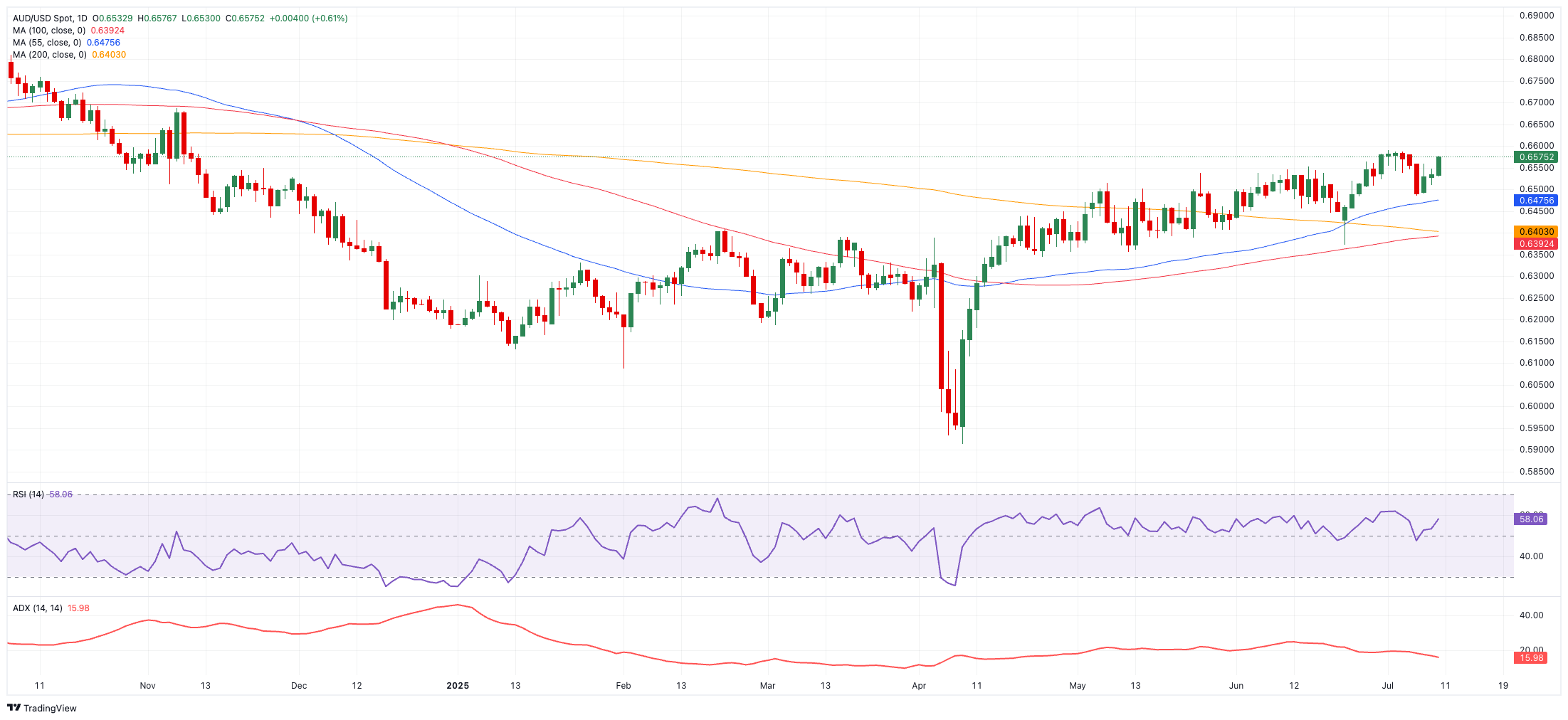
- AUD/USD extends its weekly advance to the 0.6570 zone on Thursday.
- The US Dollar remains on the positive foot on trade and hawkish Fedspeak.
- The White House’s trade policy dominates the market amidst ongoing tariff threats.
The Australian Dollar (AUD) continued to rise on Thursday, with AUD/USD moving back into the 0.6570–0.6580 region, up for the third consecutive day.
The RBA surprises to the upside and hints at a dovish tilt
The Reserve Bank of Australia (RBA) kept its benchmark interest rate at 3.85% on Tuesday, which was not what most people thought would happen as consensus had almost fully priced in a quarter point rate cut. Not all board members agreed on the decision, as six decided to keep it the same, while three wanted to lower it.
Later, Governor Michele Bullock said that the split was more about time than direction. She also said that the board was leaning towards making policy easier, as long as the second quarter’s inflation data matches what was expected.
In reality, markets quickly adjusted, as futures now show a nearly 90% possibility of a rate drop in August, while the terminal rate projection has gone up slightly from 2.85% to 3.10%.
China shows signs of prosperity, yet there are some caveats.
The economic statistics from China, a crucial trade partner, was not all good. In May, industrial output, retail sales, and services activity all got better. The official PMI readings stayed close to the line between expansion and contraction, which supports a GDP growth prediction of around 5% for 2025.
Still, China’s housing market is still sluggish, and stimulus measures are slowly being rolled back, which makes the future appear uncertain and poses concerns for Australia’s commodity-driven economy.
Also, inflation in China is still low, with consumer prices only going up 0.1% in June from the same month last year.
Different stories from the central banks?
The RBA’s careful tone was similar to the Federal Reserve’s (Fed) decision in June to keep interest rates the same. But lately, Fed Chair Jerome Powell said that US tariffs might cause goods prices to rise again, which could make the two central banks’ policy courses even more different if inflation rises unexpectedly.
Positioning shows a change in sentiment
The most recent CFTC statistics through July 1 indicate that speculative net short positions in the Aussie fell to just over 70K contracts, or two-week low. At the same time, open interest grew for the third week in a row to around 151.4K contracts, which suggests that negative sentiment is weakening.
Technical picture: There is resistance ahead, but the trend is unclear.
AUD/USD has to break above the 2025 high of 0.6590 (June 30) to allow a potential visit to the November 2024 top of 0.6687, and finally the important 0.7000 barrier.
The 200-day simple moving average (SMA) at 0.6408 is a level of support, followed by the June low of 0.6372 (June 23) and the May low of 0.6356. If these levels are broken, the 0.6000 level might be reached before the 2025 base level of 0.5913 (April 9).
The momentum indicators are sending forth different indications. The Relative Strength Index (RSI) is close to 58, which is a good sign, but the Average Directional Index (ADX) is close to 17, which means that the trend strength is weak.
AUD/USD daily chart

Outlook: For now, it’s stuck in a range.
The Australian Dollar may stay in its current range until Beijing or the US make a big change in its trade policy or the US makes a big change in its trade policy. The RBA is suggesting a cautious relaxing path, and China’s recovery is still uneven, so AUD/USD doesn’t seem to have a lot of room to go higher right now.
Australian Dollar FAQs
One of the most significant factors for the Australian Dollar (AUD) is the level of interest rates set by the Reserve Bank of Australia (RBA). Because Australia is a resource-rich country another key driver is the price of its biggest export, Iron Ore. The health of the Chinese economy, its largest trading partner, is a factor, as well as inflation in Australia, its growth rate and Trade Balance. Market sentiment – whether investors are taking on more risky assets (risk-on) or seeking safe-havens (risk-off) – is also a factor, with risk-on positive for AUD.
The Reserve Bank of Australia (RBA) influences the Australian Dollar (AUD) by setting the level of interest rates that Australian banks can lend to each other. This influences the level of interest rates in the economy as a whole. The main goal of the RBA is to maintain a stable inflation rate of 2-3% by adjusting interest rates up or down. Relatively high interest rates compared to other major central banks support the AUD, and the opposite for relatively low. The RBA can also use quantitative easing and tightening to influence credit conditions, with the former AUD-negative and the latter AUD-positive.
China is Australia’s largest trading partner so the health of the Chinese economy is a major influence on the value of the Australian Dollar (AUD). When the Chinese economy is doing well it purchases more raw materials, goods and services from Australia, lifting demand for the AUD, and pushing up its value. The opposite is the case when the Chinese economy is not growing as fast as expected. Positive or negative surprises in Chinese growth data, therefore, often have a direct impact on the Australian Dollar and its pairs.
Iron Ore is Australia’s largest export, accounting for $118 billion a year according to data from 2021, with China as its primary destination. The price of Iron Ore, therefore, can be a driver of the Australian Dollar. Generally, if the price of Iron Ore rises, AUD also goes up, as aggregate demand for the currency increases. The opposite is the case if the price of Iron Ore falls. Higher Iron Ore prices also tend to result in a greater likelihood of a positive Trade Balance for Australia, which is also positive of the AUD.
The Trade Balance, which is the difference between what a country earns from its exports versus what it pays for its imports, is another factor that can influence the value of the Australian Dollar. If Australia produces highly sought after exports, then its currency will gain in value purely from the surplus demand created from foreign buyers seeking to purchase its exports versus what it spends to purchase imports. Therefore, a positive net Trade Balance strengthens the AUD, with the opposite effect if the Trade Balance is negative.
Information on these pages contains forward-looking statements that involve risks and uncertainties. Markets and instruments profiled on this page are for informational purposes only and should not in any way come across as a recommendation to buy or sell in these assets. You should do your own thorough research before making any investment decisions. FXStreet does not in any way guarantee that this information is free from mistakes, errors, or material misstatements. It also does not guarantee that this information is of a timely nature. Investing in Open Markets involves a great deal of risk, including the loss of all or a portion of your investment, as well as emotional distress. All risks, losses and costs associated with investing, including total loss of principal, are your responsibility. The views and opinions expressed in this article are those of the authors and do not necessarily reflect the official policy or position of FXStreet nor its advertisers. The author will not be held responsible for information that is found at the end of links posted on this page.
If not otherwise explicitly mentioned in the body of the article, at the time of writing, the author has no position in any stock mentioned in this article and no business relationship with any company mentioned. The author has not received compensation for writing this article, other than from FXStreet.
FXStreet and the author do not provide personalized recommendations. The author makes no representations as to the accuracy, completeness, or suitability of this information. FXStreet and the author will not be liable for any errors, omissions or any losses, injuries or damages arising from this information and its display or use. Errors and omissions excepted.
The author and FXStreet are not registered investment advisors and nothing in this article is intended to be investment advice.








